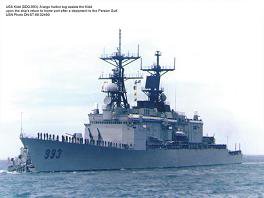Kidds Boost Navy

DefenseTech is reporting on the transfer of the Kidd class of missiles destroyers to Taiwan, greatly boosting the fighting power of that fleet. Also some interesting observations on the Chinese navy, which is not as formidable as you usually hear:
Besides significantly bulking up Taiwan’s navy, the Kidds will give the force its first modern air-defense capability and should prove a significant deterrent against China’s largely-outdated surface fleet, which depends heavily on land-based air cover. The Kidd deal has understandably angered China. While many in the U.S. are eager to tout China as the next superpower and a naval rival, cooler heads point out that China is heavily dependent on maritime trade and energy imports and that its naval modernization is largely intended to secure sea lines of communication and to counterbalance Indian intrusion into regional waters. Besides, on the seas China is still a generation behind the U.S. and years behind Taiwan. The Kidds only extend that disparity.
An article from Taiwan about the state of Red Navy also touches on this subject. From an interview with a retired Japanese Admiral:
Regarding PLAN's ability to project power, its range only extends to the waters around Taiwan. PLAN's submarines have a very limited ability to prevent the US and Japanese navies from projecting their power to the waters around Taiwan.
As for its ability to control sea lanes, it would be impossible for PLAN to control the waters between China and Taiwan if it faced a US and Japanese joint naval force. In contrast, within the so-called first island chain [islands including the Aleutians, Japan, South Korea, Okinawa, Taiwan, the Philippines and Singapore], PLAN has a very limited capability to deny the US and Japan command of the seas.
So if China invaded Taiwan, PLAN would not be able to sustain logistic support from China because it cannot control the waters between Taiwan and China.


